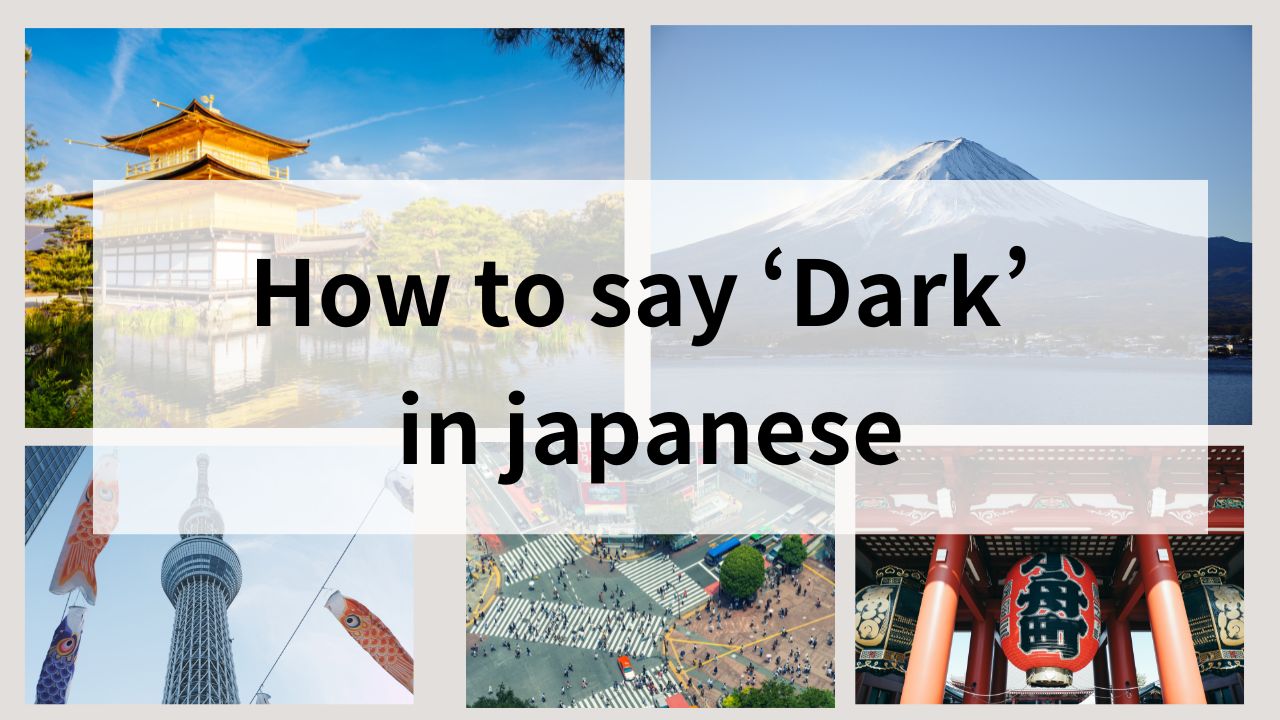Are you curious about how to say “dark” in Japanese? The concept of darkness encompasses various cultural meanings and associations in Japan, from aesthetics to symbolism. This guide will explore the Japanese word for “dark,” its cultural significance, and practical applications.
How Do You Say “Dark” in Japanese?
The Japanese word for “dark” is 暗い (kurai). This term is widely recognized and used in both casual and formal contexts. The concept of darkness in Japan often evokes feelings of mystery, depth, and sometimes even fear.
The Japanese Word for Dark: Kurai (暗い)
“Kurai” is commonly used to describe a lack of light or to convey a sense of gloom. For example:
- 暗い部屋 (Kurai heya): “Dark room.”
- 暗い雲 (Kurai kumo): “Dark clouds.”
- 暗い道 (Kurai michi): “Dark road.”
Kanji for Dark: 暗
The kanji for dark, 暗, is often used in literature, traditional contexts, and everyday language. This character visually represents the concept of darkness. The primary reading for this kanji is くら (Kura), but it can also be read as あん (An) in compound words.
Examples of words containing the kanji 暗 include:
- 暗闇 (Kurayami): “Darkness,” referring to a pitch-black environment.
- 暗証番号 (Anshō bangō): “PIN number,” where the concept of security is linked to the idea of keeping something hidden or dark.
- 暗号 (Angō): “Cipher,” representing coded messages that are difficult to decipher, often associated with secrecy and darkness.
This kanji is commonly associated with elements that evoke a sense of mystery or secrecy. Recognizing these patterns can help learners understand the nuanced use of 暗 in Japanese.
Does “Dark” Work in Japanese?
The English word “dark” is generally understood in Japan, especially among younger generations or those familiar with modern language and culture. However, its recognition might be less universal among older individuals or in more traditional contexts. A 5-point scale rates its comprehension as:
- Rating: 4 – Generally understood (60-80% of people)
Rating Details
Understanding the 5-Point Rating for English Words in Japan
The following ratings help explain how English words are typically understood in Japan. The scale is based on context, familiarity, and the target audience.
- 5 - Universally understood (80% or more):
Words that are widely adopted into everyday Japanese, such as "coffee" (コーヒー) or "computer" (コンピューター). These words are part of the standard vocabulary and are recognized by nearly everyone. - 4 - Generally understood (60-80%):
Words that are familiar to most people but might require context for full comprehension. Examples include terms commonly used in specific industries or by younger generations. - 3 - Understood in half of the cases (40-60%):
Words that depend heavily on pronunciation or context. For example, technical terms or less common foreign words that some people may not immediately recognize. - 2 - May not be understood (20-40%):
Words that are unfamiliar to most Japanese speakers unless they have significant exposure to English or specific cultural contexts. These words are often better replaced with their Japanese equivalents. - 1 - Rarely understood (20% or less):
Highly specialized or obscure terms that are unlikely to be recognized by the general public. Clear communication requires the use of Japanese vocabulary or additional explanation.
This rating system provides a practical guide for determining when and how to use English words effectively in Japan. Understanding the audience and context is key to ensuring clear communication.
If clarity is crucial, using the Japanese term 暗い (Kurai) is recommended. While “dark” may be understood in certain contexts, “kurai” ensures effective communication.
The Cultural Significance of Darkness in Japan
Darkness has held a special place in Japanese culture for centuries, symbolizing mystery, depth, and sometimes fear. It is often associated with the supernatural and the unknown.
Darkness as a Symbol of Mystery
In Japanese folklore, darkness is frequently depicted as a realm where spirits and supernatural beings dwell. This connection adds an air of mystique to the concept of “kurai.”
Darkness in Japanese Folklore and Mythology
Darkness appears in various Japanese myths and stories, often symbolizing the unknown and the supernatural. It is sometimes linked to deities and spirits, enhancing its mystical qualities.
In addition to its traditional associations, darkness plays a significant role in modern Japanese pop culture, particularly in anime and games. This connection further emphasizes the concept’s enduring mystique.
- Death Note: The character Light Yagami operates in the shadows, representing the moral ambiguity of his actions and the darkness within.
- Attack on Titan: The Titans symbolize the fear of the unknown, represented by their dark and ominous appearances.
- Spirited Away: The film includes elements of darkness that represent the unknown and the journey into the spirit world.
- Japanese Horror Films: Many horror films utilize darkness to evoke fear and suspense, creating an atmosphere of dread.
These examples demonstrate how darkness continues to represent mystery and the unknown, bridging traditional folklore and modern storytelling.
Differences Between Dark in Japan and Overseas
Yes, there can be subtle differences in how “dark” is perceived in Japan versus Western cultures. In Japan, “kurai” (暗い) often conveys a sense of melancholy or introspection, while in Western contexts, “dark” may evoke more straightforward connotations of evil or fear. Understanding these cultural nuances can help avoid confusion, especially when discussing themes in creative or professional settings.
Practical Applications of “Dark” in Japanese
Learning how “dark” is used in Japanese can help you navigate conversations, understand idioms, and recognize its presence in Japanese culture.
Talking About Darkness in Daily Conversation
Here are some examples of how “kurai” is used in everyday conversation:
- この部屋は暗いです (Kono heya wa kurai desu): “This room is dark.”
- 暗い気持ち (Kurai kimochi): “Dark feelings,” often referring to sadness or depression.
Dark-Related Idioms or Expressions
While there are relatively few specific idioms involving “kurai,” the concept is often associated with feelings of sadness, mystery, and introspection. Here are some idioms, phrases, and expressions that incorporate or symbolize darkness:
- 暗中 (Anchuu): “In the dark,” often used to describe actions taken secretly or without knowledge.
- 暗雲 (Ankun): “Dark clouds,” symbolizing impending trouble or misfortune.
- 暗黒 (Ankoku): “Darkness” or “dark age,” often used in historical or philosophical contexts to denote periods of turmoil.
- 暗い影 (Kurai kage): “Dark shadow,” representing a negative influence or presence.
- 暗い未来 (Kurai mirai): “Dark future,” often used to express pessimism about what lies ahead.
These idioms and expressions reflect the deep cultural and aesthetic appreciation of darkness in Japan, often tied to themes of mystery, sadness, and introspection. By learning these phrases, you can gain a deeper understanding of how darkness is interwoven with Japanese language and values.
Darkness in Japanese Cuisine or Products
Darkness is also prominently featured in Japanese cuisine and products, showcasing its aesthetic appeal and cultural significance. Here are some notable examples:
- Black Sesame (黒ごま, Kuro goma): Used in various dishes and desserts, black sesame has a rich flavor and is often associated with health benefits.
- Black Beans (黒豆, Kuro mame): A staple in Japanese New Year’s dishes, black beans symbolize health and prosperity.
- Dark Soy Sauce (濃口醤油, Nokuchi shōyu): Known for its rich flavor, dark soy sauce is essential in many traditional Japanese recipes.
These examples highlight how darkness is not only visually appealing but also culturally significant in Japanese cuisine, adding depth and richness to both traditional and modern dishes.
FAQs
Here are some frequently asked questions about darkness in Japanese culture and language.
Is Dark a Popular Concept in Japan?
Yes, darkness is a popular concept in Japan, often associated with mystery and depth. It is frequently used in literature, art, and pop culture.
How Do You Write “Dark” in Japanese?
The word “dark” can be written in three different scripts in Japanese: hiragana, katakana, and kanji. Each script serves different purposes depending on the context and formality. Here’s a breakdown:
- Hiragana (くらい, Kurai):
Hiragana is the most commonly used script for “dark” in casual writing or when teaching children. It is simple and easy to read, making it ideal for everyday use. - Katakana (クライ, Kurai):
Katakana is rarely used for “dark,” but it may appear in stylistic contexts, such as advertisements, product names, or when emphasizing the word in text. - Kanji (暗, Kurai):
Kanji is the most formal and traditional way to write “dark.” It is often used in literature, official documents, and cultural contexts. The kanji itself conveys a sense of depth and seriousness.
Choosing which script to use depends on the tone, audience, and purpose of your communication. Understanding these variations can enhance both your written and spoken Japanese skills.
Conclusion
Darkness, or “kurai” in Japanese, is more than just a lack of light—it symbolizes mystery, depth, and cultural significance. By understanding its role in Japanese language and traditions, you can deepen your appreciation for this profound concept and its place in Japanese society.








